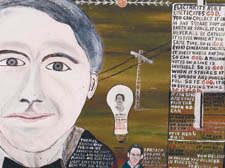|
|
 |
| |

The Museum of Everything |
The secret world of ‘outsider’ art
The recently opened Museum of Everything is showcasing the work of reclusive artists that were probably never intended for galleries, writes Simon Wroe
SISTER Gertrude Morgan, the self-proclaimed “Bride of Christ”, received her first and only artistic commission from God himself; Madge Gill, a Hackney medium, drew thousands of biro portraits under the aegis of a spirit called Myrninerest; and Howard Finster was commanded to “make sacred art” by his left index finger. As everybody knows, you cannot argue with a finger.
It would have been a memorable private view indeed if half of the prophets, preachers, recluses and mental patients featured in Primrose Hill’s recently opened Museum of Everything were still alive, though paradoxically the exhibition would probably never have taken place if they were.
Many of the artists would have baulked at the idea of their intensely private works on display: several, such as the Chicago janitor Henry Darger, whose beautiful, uncanny drawings of seven imaginary sisters were only discovered after his death in 1973, did not show their work to another soul during their lifetimes.
Escape was probably foremost on the mind of butcher Charles Dellschau when he drew his colourful time machines on greaseproof paper in the early 20th century. Prophet Royal Robertson painted his most vitriolic signs for an ex-wife, and the Reverend William Blayney, if his “All rights reserved” illustrations of the Book of Revelations are anything to go by, wanted plagiarists to burn in the fiery depths.
“These works lack the inverted commas that go round most artists’ work. There is a compulsion to create in all of them,” explains James Brett, the museum’s curator.
Brett, a film-maker by profession who was born and raised in Camden, cheerily admits he is unsure exactly what he looks for in a work. He loathes the “outsider art” sobriquet commonly applied to the genre – “It puts it in a box” – but acknowledges an element of isolation is crucial.
“If a developmental disability is not involved, something’s got to happen to blinker that person away from the idea of being in the market,” he says.
“Henry Darger would never have made his work had he somehow engaged with the modern world. Let’s say a gallery had found him mid-career, it probably would have destroyed him,” adds Brett, pointing to the example of Morton Bartlett, whose creepy pre-pubescent dolls inhabit a small room in the rambling former dairy off Regent’s Park Road.
Bartlett stopped making art after an article revealed his strange world to a sententious public. Ironically, popular mainstream artists such as Grayson Perry and Cindy Sherman now cite his work as an inspiration.
How does Brett feel seeing these motifs recycled in the work of expensive, media-savvy artists today?
“Superior,” he says after a pause. “I think they’re looking for a depth, which often they don’t have.”
Brett has been criticised for not respecting his artists by folk-art purists who object to the deliberately cluttered presentation of some of the pieces, and for promoting perceived sexual perversions of troubled individuals like Darger. Then there is Emery Blagdon and his ilk. A Nebraskan hobo who built complicated healing machines out of wire to give him immortality, Blagdon died penniless but his work now turns hefty profits for art collectors.
For every sad tale in the museum, however, there is an uplifting counterpart. Art is a demonstrably powerful form of expression for psychiatric and handicapped patients at California’s Creative Growth Centre and the Gugging atelier in Austria. Or take the story of Nek Chand, the Indian roadworker who has been granted an estate in the city of Chandigarh to display the thousands of statues he cobbled together from street detritus.
Like the artists he champions, Brett is a very private person. Though he is obviously proud of the attention the exhibition has generated in the art world, one senses there is a part of him that would have preferred for the exhibition to be mothballed, ignored and uncelebrated, for the secret to remain a secret.
•
|

|
 |
| |
|
 |
|

